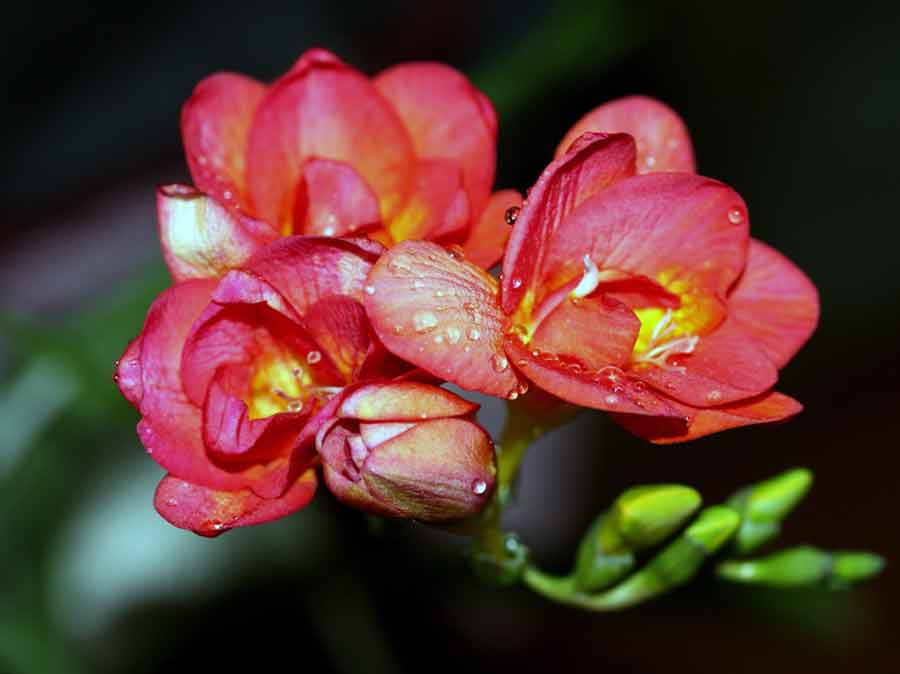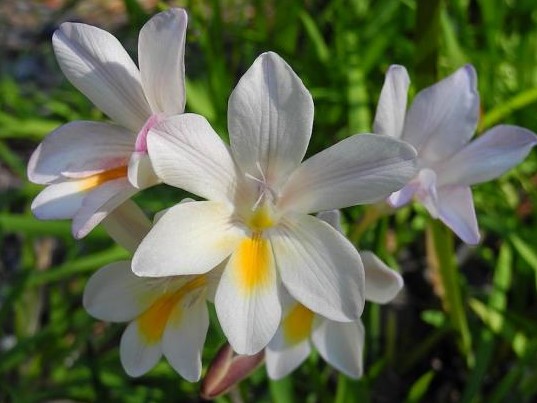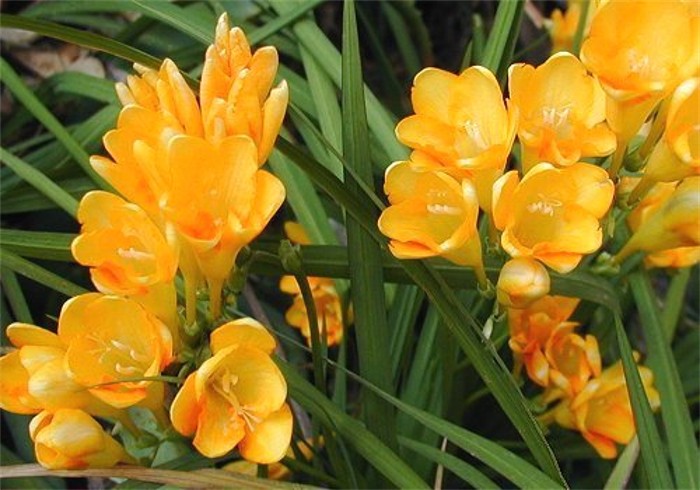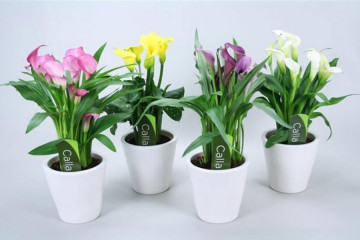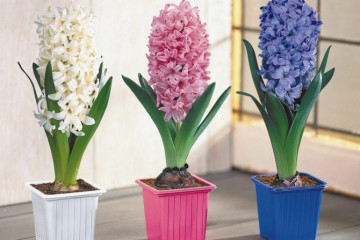Freesia cultivation and care at home and in the garden
Content:
Freesias belong to the Iris family. They can be grown in a greenhouse, garden, indoor pot. Flowering time is from April to October. Houseplants bloom mainly in spring.
Freesia types and popular varieties
On sale you can find both freesia mix and classic plant varieties. The most popular ones are Armstrong's freesia, broken freesia and hybrid freesia.
Armstrong (Freesia Armstrongii)
Plant height 65 cm (+/- 5 cm). Bell-shaped flowers are red, pink or crimson and are collected in inflorescences of 3-5 pcs. The leaves are xiphoid and long. The plant blooms from May to June.
Alba (Freesia Refracta var. Alba)
Alba is a subspecies of white (refracted) Freesia Refracta. It has snow-white large flowers with a yellow-pink core. The petals have purple streaks. Small plant (about 40 cm). Flowering begins in April.
Fragrant (Freesia Refracta Odorata)
Another subspecies of Freesia Refracta. A plant with lush inflorescences of 5-7 flowers. They have a delicate peach color with red veins. Freesia exudes a rich scent of lily of the valley. Height 40-50 cm. Flowering from April to May.
Reproduction methods used for garden and indoor flowers
Freesia propagates using daughter bulbs or seeds. For beginners, the first method is suitable, with its help you can quickly and easily get a new plant.
Bulb propagation
During flowering, babies begin to appear at the mother bulb. After shedding dry buds, you need to cut off any remaining flowers and foliage. If this is not done, the plant will spend resources on seed formation rather than bulb growth.
The babies are separated from the mother's bulb and stored separately. Daughter bulbs are planted in the ground at the same time as mother bulbs in late April - early May. A mixture of sand and crushed coal should be added to the planting hole.
Seed propagation
Not the most common way of plant propagation, as the process takes a year. The best period for sowing seeds in the ground is the beginning of spring. Freesia seeds are burgundy, glossy, similar to berries.
In early March, they are soaked in cold water for 24 hours. Then the seeds are sown shallowly into a nutrient mixture of humus, sand and peat. It is necessary to use an expanded clay drainage layer, as excess water will destroy the plant.
Cover the pot with plastic wrap. It should be opened twice a day for airing. Small shoots will appear within 1-2 weeks, which should be irrigated frequently with a spray bottle. After a month, the film is removed.
Freesia: growing and care in the open field
In Central Russia, planting in open ground is carried out in early spring.In the climatic conditions of the Urals and Siberia, it is much more difficult to grow freesia. Due to the short summer, a plant with a long growing season does not have time to germinate and bloom. For this reason, it is grown at home in a pot and only before flowering is planted in open ground. Growing in a greenhouse is also possible.
Preparing the bulbs for planting
Freesia should be prepared for planting at the end of March. The bulbs that were hibernating are moved, cleaned and soaked for 1 hour in a fungicide. Then they can be planted in the ground.
Landing in open ground
The depth of the hole should be about 5 cm, and the distance between the tubers should be 5-10 cm. After planting, the ground must be leveled and sprinkled with peat so that the roots of the shrub do not overheat. In August, flowering will begin, which will last until early October.
To avoid stagnant water, which can kill freesia, it is necessary to provide a good drainage layer. A layer of expanded clay is poured into a furrow 15 cm deep. Above is a nutritious soil, on which bulbs or a germinated tuber with a plant are placed. All this is then sprinkled with earth.
How to care during growth and flowering
During growth, the freesia shrub needs feeding. On the shoots, they are treated with ammonium nitrate, then superphosphate and potassium salt every two weeks. Freesia, grown and cared for in the garden, is watered abundantly every morning. The land must be loosened and weeded.
How to prepare a plant for winter
After the end of flowering, watering is reduced, and then stops altogether. The bulbs remain in the soil until early October. In order for the plant to survive the winter, they must be sent for storage.
Storing the bulbs
The bulbs should be dug up, cut off the remaining leaves, rinsed under cool water and soaked in a solution of potassium permanganate for 1 hour. Then they should be dried for five days in a dry place.
Freesia: planting and caring for a flower in a pot at home
Freesia, which is easy and simple to grow and care for at home, is planted in three seasons to choose from:
- from mid-August to mid-October;
- from mid-May to mid-August;
- from mid-November to mid-February;
Plants are placed in a pot with an earthen mixture of turf, peat and sand in a 2: 1: 1 ratio. In a pot with a volume of 3 liters, you can plant no more than six tubers.
Conditions of detention
Freesia is a light-loving plant and requires 12 hours of light per day. It dies from exposure to direct sunlight, so it is necessary to keep it in partial shade.
Humid air is preferable for freesia, but fungal diseases can develop from excess moisture in the air or soil. It is necessary to spray the flower from a spray bottle so that water does not get inside the buds.
Features of watering and feeding
The only fertilizer format that freesia can absorb at home is liquid products. In the early stages of growth, fertilizers with nitrogen, iron, phosphorus, manganese are used. Yellowed leaves are a signal that the plant is overfed.
Watering and feeding is carried out in the morning. There should be a drainage layer in the pot. The plant is sensitive to watering: excess or lack of water is unacceptable. The soil is watered as it dries.
Freesia diseases
The plant faces the same diseases and pests as gladioli. As a result of improper care, freesia can suffer from aphids, ticks, thrips. The most common diseases: rot, scab, fusarium. In case of damage to the plant, the diseased areas should be immediately removed.
For prevention, you can treat the bulbs with disinfectants, for example, during the transplantation process.Both store-bought products (fungicides) and a weak solution of potassium permanganate are suitable. Another way to prevent infestation is to avoid using too cold water for irrigation. The best option is water, which has stood for several days.
Thus, freesias can be planted both in a flower garden on the street and at home in a pot. The main thing is to study the instructions so as not to confuse anything, otherwise you can not wait for the flowering of the representative of the Irisovs.

